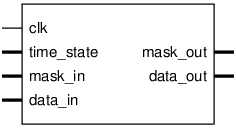Attention
This documentation is a work in progress. Expect to see errors and unfinished things.
banyan
Description
permute np ports, each dw bits wide, using rl levels of 2-way mux
np must be 2**rl
Networking equipment with similar topology is known as a Banyan switch,
so I’ll use that name. A non-folded Banyan switch actually has two
switches of this type back-to-back; I can leave off the second half
because in my application the output channels are fungible.
The intended use case is to route 8 x ADC data to 8 x data sinks,
in any of the following configurations:
8 parallel : 1 combination x 1 time state
4 parallel : 70 combinations x 2 time states
2 parallel : 28 combinations x 4 time states
1 at a time : 8 possibilities x 8 time states
for 1*1 + 70*2 + 28*4 + 8*8 = 317 useful configurations
Represent the channel selection configuration with an 8-bit mask of
which channels to look at. Only 1+70+28+8 = 107 of 256 possible masks
are valid, since it’s invalid to have 0, 3, 5, 6, or 7 bits set.
Configuration also includes 3 bits of time_state.
time_state and mask_in are processed at full bandwidth.
There are rl+1 cycles of latency from a change of these
control inputs to the new data_out permutation appearing.
There are only rl cycles of latency to mask_out.
The implementation is done with recursive instantiation of itself.
The capability of doing recursion in Verilog is explicitly acknowledged
and blessed by the Verilog-2005 standard, and it works without problem
for me in Icarus Verilog, Verilator, Xilinx XST, and Xilinx Vivado.
An N=8 dw=16 instantiation in Kintex speed grade 2 seems capable of
running at ridiculous clock rates (over 550 MHz?), consuming on the
order of 430 LUT. The data muxes alone ought to use 384 LUT outputs.
Even a lowly Spartan-6 should manage 160 MHz, using about 226 LUT
(437 LUT outputs).
Used successfully on hardware since 2016.
Pinout

Parameters
Name |
Min |
Max |
Default |
Description |
|---|---|---|---|---|
dw |
? |
? |
16 |
data width |
np |
? |
? |
8 |
number of ports, must be a power of 2 |
rl |
? |
? |
3 |
number of routing layers == log_2(np) |
Ports
Signal |
Direction |
Description |
|---|---|---|
clk |
Input |
|
time_state[rl-1:0] |
Input |
|
mask_in[np-1:0] |
Input |
|
data_in[dw*np-1:0] |
Input |
|
mask_out[np-1:0] |
Output |
for DPRAM write-enable |
data_out[dw*np-1:0] |
Output |
Implementation and use
The portable Verilog implementation can be found in banyan Source File